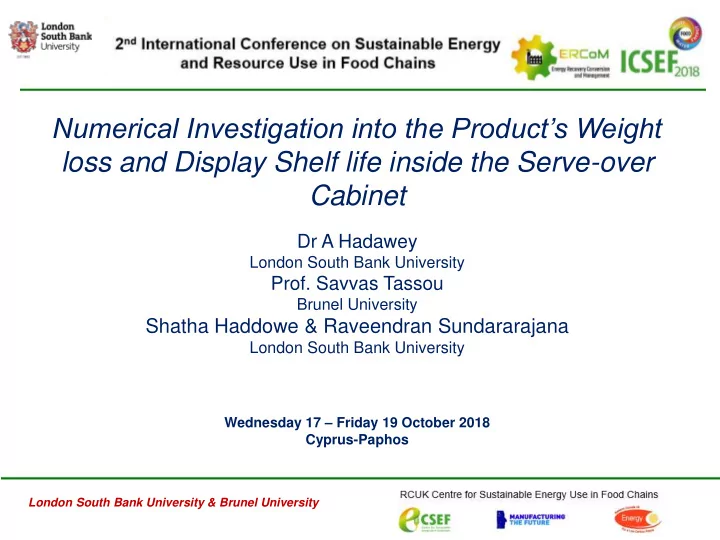

Numerical Investigation into the Product’s Weight loss and Display Shelf life inside the Serve-over Cabinet Dr A Hadawey London South Bank University Prof. Savvas Tassou Brunel University Shatha Haddowe & Raveendran Sundararajana London South Bank University Wednesday 17 – Friday 19 October 2018 Cyprus-Paphos London South Bank University & Brunel University
INTRODUCTION Recent years have seen an increase in customer demand for fresh food, which has caused a major increase in the volume of sales of unwrapped chilled food in display cabinets. The UK market for chilled ready meals has grown from an estimated £173 million in 1988 to £11876 million in 2017 Surface drying has been identified as the main reason for commercial loss from unwrapped chilled food in display cabinets The output of this work will provide the required knowledge to build a database that may provide some of the process information that industry requires to both improve existing refrigerated display cabinets and design new display cabinets for unwrapped chilled food products.
OBJECTIVE To develop a CFD model for a serve-over display cabinet to include evaporating losses, which can be used to predict the drying rate and display shelf life of a product inside the cabinet under specific operating conditions. MODELLING CONCEPT A meat baguette sandwich, consisting of baguette and meat (beef) as filling was considered in this investigation Beef Baguette Meat baguette sandwich in real display cabinet Beef Meat baguette sandwich in the CFD model Baguette Representation of the sandwiches in the 2D CFD model of the serve-over display cabinet
MODELLING THE EVAPORATING LOSS The process of weight loss is not a steady Mass transfer from any food item depends on state process; it is a function of the evaporation, where the water vapour transfers environmental boundary conditions and from the product surface to the surrounding air food characteristics. Modelling the and on diffusion, where the water from within evaporating losses in Fluent only the food moves to the surface. considers the evaporating from food surface during steady state Modelling the evaporating losses in Fluent involved adding a source of water vapour (H2O) on the food surface. The cells that in direct The evaporating losses will contribute to the contact with the food surface are therefore, latent load of the display case by increasing the considered to be a source of water vapour amount of water vapour (mass fraction of H 2 O ) (H2O) entering the evaporator coil. The drying rate 𝑙/𝑡𝑓𝑑 was evaluated by obtaining the mass flow rate of the evaporated water vapour from the beef inside the cabinet by running the CFD model with and without the source of H 2 O , the difference of the water vapour mass flow rate at the air-on section for both models represents the amount of water vapor evaporated. Cross-Section of the Beef Baguette Sandwich with Water Vapour Source Cells
MODELLING THE EVAPORATING LOSS THEORETICAL BACKGROUND The rate at which a food product loses weight through its surface depends on two related processes: evaporation and diffusion. Dalton’s law Antonine equation Τ ሻ 𝑒 𝑁 𝑒 𝑢 = 𝐵𝐿 𝑓 (𝑄 𝑡 − 𝑄 𝑏 Τ ሿ 𝑄 𝑏 = 𝐼𝑠. 𝑄 𝑄 𝑥 ≈ exp [23.4795 − 3990.5 ( 𝑈 + 233.833ሻ 𝑄 𝑡 = 𝑏 𝑥 . 𝑄 𝑥𝑏 𝑥𝑡 It was assumed that the temperature 𝐼𝑠 is the ratio of the actual water vapour pressure to the 𝑥 𝑄 of the source cells was the same as 𝐼𝑠 = saturation water vapour pressure and cannot be applied directly 𝑞 𝑥𝑏 (0.622 + 𝑥ሻ that of the food surface in Fluent; it has to be introduced in terms of a mass fraction of water vapour 𝑥 𝒍𝒉/𝒕𝒇𝒅 The drying rate (kg/s.m²) was obtained by dividing the evaporation losses by the surface area of the beef. The shelf life was then determined using the showing figure.
CFD RESULTS
MODEL VALIDATION Comparison of experimental temperature (°C) with simulation results inside the display cabinet Comparison of experimental relative humidity (%) with simulation results inside the display cabinet Comparison of experimental air velocity (m/s) with simulation results inside the display cabinet
MODEL VALIDATION Comparison between drying rate and display shelf life predicted by the model with experimental results at 25 °C and 40 % RH
SIMULATION RESULTS Constant 𝑤 = 1.48 𝑛/𝑡 𝑏𝑜𝑒 𝑆𝐼 = 73% Effect of air-off (air curtain) on the Effect of air-off (air curtain) on local air boundary conditions drying rate Effect of air-off (air curtain) on display shelf life
SIMULATION RESULTS Constant 𝑈 = 2.5°𝐷 𝑏𝑜𝑒 𝑤 = 1.48 𝑛/𝑡 Effect of air-off (air curtain) on Effect of air-off (air curtain) the local air RH RH (%) on the drying rate Effect of air-off (air curtain) RH (%) on the display shelf life
SIMULATION RESULTS Constant 𝑈 = 2.5°𝐷 𝑏𝑜𝑒 𝑆𝐼 = 73% Effect of air curtain velocity on the local Effect of air-off (air curtain) air boundary conditions velocity on the drying rate Effect of air-off (air curtain) velocity on the display shelf life
CONCLUSIONS The CFD model was able reasonably to predict the drying rate of unwrapped food product inside a refrigerated display cabinet under different boundary conditions of air temperature, velocity and relative humidity. The relative humidity had the most prevalent effect on the drying rate. Temperature changes had smaller effect on drying rate compared to the changes in either relative humidity or air velocity. Air velocity directly affects the drying rate and this is related to the relative humidity. The magnitude of the effect increases as relative humidity decreases. The display shelf life was mostly affected by air relative humidity and velocity. Changes in air velocity at high relative humidity had more effect on display shelf life than at low relative humidity.
Recommend
More recommend